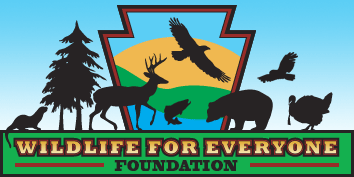Conservation at Wildlife for Everyone Foundation
Our Commitment
The Wildlife for Everyone Foundation is dedicated to safeguarding Pennsylvania’s wildlife and natural habitats for current and future generations. Our mission is to promote wildlife conservation and education throughout the Commonwealth.
We believe that healthy ecosystems, robust populations of native species, and accessible wild places are essential—not just for wildlife, but for people’s enjoyment, identity, and wellbeing. Conservation isn’t a passive effort; it’s an active responsibility involving habitat protection, restoration, scientific research, public education, and inclusive community participation.
What We Do
Here are some of the key ways the Foundation carries out its conservation goals:
Habitat & Wetland Restoration
We fund and support projects that restore wetlands, improve wildlife habitats, and repair or enhance creeks and lakes. These ecological improvements help sustain the 480 species of birds and mammals (and Pennsylvania’s fisheries) that call this state home.Seedlings for Schools & Pollinator Gardens
We support programs that bring native plants into schoolyards and other public areas, helping students learn about local ecosystems, the role of pollinators, and the importance of plant diversity.Educational Outreach & Youth Engagement
Through scholarships, workshops, field experiences, and classroom resources, we help cultivate the next generation of conservationists. We believe building awareness and hands‐on connection with nature is a cornerstone of lasting conservation.Wetlands & Outdoor Access Projects
We develop outdoor learning spaces like the Soaring Eagle Wetland, with emphasis on accessibility. These spaces serve both wildlife and people—providing observatories, trails, viewing areas, and opportunities for direct interaction with nature.Wildlife Research & Monitoring
Supporting scientific research and wildlife management efforts allows us to base our work on solid data. We help fund projects that monitor the status of species, study habitat use, and evaluate conservation interventions.
Conservation Principles We Uphold
These are the values and guiding principles that shape how we approach conservation:
Scientific Rigor & Evidence
We use the best available science in planning, implementing, and evaluating conservation actions.Biodiversity First
Protecting a wide array of species (plants, animals, aquatic life) and their genetic, species, and ecosystem diversity is central to our work.Sustainability & Perpetuity
Conservation actions should not just have short‐term impacts; they must be sustainable over time, ensuring that habitats and species continue to thrive. Our endowment work and capital campaigns reflect this long‐view.Accessibility & Inclusiveness
Nature is for everyone. We strive to make conservation sites accessible (e.g. ADA‐compliant), and our programs inclusive—so people from all backgrounds, ages, and abilities can participate.Education & Community Engagement
Conservation is stronger when people understand how ecosystems work and feel a stake in their protection. Educating youth, involving volunteers, partnering with schools and local communities are essential.Habitat Protection & Restoration
Preserving existing natural areas, as well as restoring degraded lands and waters, is a critical component of ensuring wildlife survival.
Why It Matters
Wildlife & Ecosystem Health: Healthy populations and habitats help maintain ecological balance—pollination, water purification, soil health, climate resiliency, etc.
Cultural & Recreational Value: Pennsylvania’s wildlife, natural scenery, and outdoor spaces are part of our shared heritage. They support recreation (hunting, birding, fishing), education, and quality of life.
Future Generations: The choices we make today affect what’s left for our children and grandchildren.
Climate Resilience: Natural systems like wetlands can buffer climate impacts—flooding, droughts, extreme weather—and help sequester carbon.
How You Can Get Involved
Donate or become a member — even small donations help fund habitat projects, scholarships, and educational outreach.
Volunteer — assist with restoration, outreach, or citizen‐science programs.
Advocate — support policies or local initiatives that protect wildlife habitat and natural resources.
Learn & Teach — attend events, use our educational materials, or bring conservation into your school, neighborhood, or family conversations.
